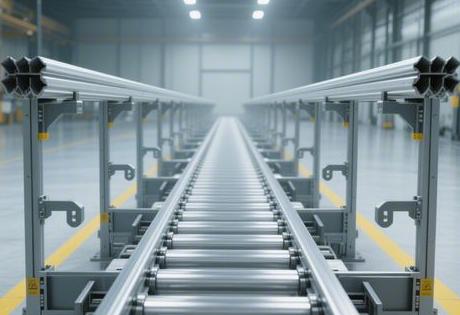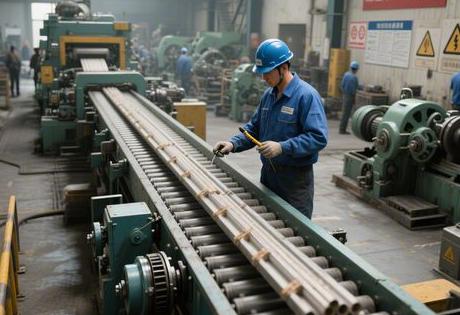Production line upgrade pain points cracked: keel conveying line selection to avoid the pit guide
In the wave of manufacturing upgrades, theConveyor system efficiency directly determines capacity bottlenecks. A food factory due to frequent jamming of the conveyor line leading to daily losses of more than 100,000 yuan, the replacement of customised keel conveyor line after the failure rate fell 90% - the cost of selection errors far exceeds the equipment itself. This paper takes the scenario-based problem as the anchor point, dismantles the matching logic of technical parameters and industry applications, and helps you avoid the selection minefield.

First, the basic knowledge: keel conveyor line why become the first choice for upgrading?
The keel conveyor line is essentiallyModular chain conveyor systemIt is designed for smooth material transfer by means of interlocking units driven by high-strength chains. The core advantage over traditional roller lines is:
- Space Utilisation Enhancement 40%: Minimum turning radius 150mm, supports S-shaped layout to bypass column obstacles
- Cleaning Cost Reduction 60%Food-grade POM material can be directly washed, no hygiene dead ends
- Compatibility RevolutionThe same system can mix and convey glass bottles, tetra packs, plastic boxes and other shaped materials.
⚠️ The first pitfall of selection: mistakenly equate "keel conveyor" with "flat-top chain conveyor". The actual difference isPitch parameters--Standard keel chain pitch is 50/63.5/82.5mm, which is more than 30% smaller than flat-top chain, so it is more suitable for precision conveying of small pieces.
II. Parameter decoding: 4 fatal parameters determine success or failure
Scene 1: Spare parts pile up in automotive welding workshop
sore point: Metal parts scratch the surface of the chain plate
prescription::
- Material preferenceStainless steel reinforced chain (35%) is used to avoid carbon steel rust and pollution.
- Bearing validation: When the weight of a single piece is >200kg, it must be equipped with a double-row chain structure (reference formula: safety factor = actual load/nominal load x 1.5).
Scenario 2: Beverage filling line bottle collapse
sore point: Sudden change in conveying speed leading to splashing of liquids
Key parameters::

- speed trap: Nominal maximum speed 90m/min, but the actual need to take the value of 70% (dry environment speed limit 45m/min)
- Non-slip design: Preference for 53.2 mm width chain plates with flanking slots (for Tetra Pak)
📊 Parameter Quick Reference Table
application scenario Recommended width(mm) Pitch (mm) material (that sth is made of) Automotive parts and components 57.2 82.5 stainless steels Dairy packaging 53.2 50 POM food grade Pharmaceutical ampoules 43.5 40 Medical Grade TPE
III. Industry adaptation: customised solutions for the three gold fields
▶ Automotive Manufacturing: Defending Precision
- Press shop: 57.2mm wide chain plate + laser positioning system (error <0.5mm)
- Welded Body-in-WhiteHigh-temperature resistant coating (130°C resistance) is mandatory to prevent welding slag burns.
▶ Food processing: hygienic grade just needed
- meat cleaver: Inclined design (15° angle) + Automatic shower system
- Baking and cooling section: Addition of anti-stick Teflon coating (dough peeling rate increased by 90%)
▶ Pharmaceutical Packaging: Clean Room Laws
- Vaccine Vial Conveyor: Fully enclosed air shower channel + static elimination module
- Cost optimisation: medical grade PP material instead of stainless steel (cost reduced by 40% and still has a life of 5 years)
IV. Intelligent upgrading: a must for the next three years
Hidden Costs Ignored in Traditional Selection: A company's retrofit costs exceeded the original cost of the equipment after 3 years because it did not reserve an IoT interface. Smart configurations that must be attended to:
- Predictive maintenance: Vibration sensor implanted in drive module, fault warning accuracy >85%
- Energy consumption black hole cracking: Servo motor + inverter control saves energy compared to conventional motors 30%
- digital twin verification: Extreme working conditions (e.g. -40°C freezers) are first tested by 3D simulation.
V. List of selected actions
- demand diagnosis: Statistical peak average daily conveyance (taking 120% safety margin)
- Environmental audit: Detection of temperature and humidity in the workshop, concentration of corrosive media
- Vendor life and death situation::
- Number of patents checked (technical barriers)
- Case study video (no posing)
- Measurement of chain plate wear resistance (on-site scratch test)
- cost reconstruction: Calculate TCO (including 10-year maintenance fee), don't be trapped by the low bidder's trap!
💎 Ultimate recommendation: co-development with head enterprises (e.g. Huixing ZhiZhuang, Shanghai Kepui)Prototype Test Lines, with 1:1 scenario validation before bulk purchase.
Conclusion: Selection is essentially a game of the system
When a new energy battery factory reduced its conveyor line failure rate from 23 times/month to 2 times, the secret was not only to meet the parameters - it was to bring theConveyor systems incorporated into production digital twins, enabling dynamic tuning. Remember: there is no perfect parameter template, only continuously evolving scene adaptation capabilities.
(Attached) Selection Quick Reference Toolkit:
▸ Load Calculator ▸ Material Corrosion Resistance Cross Reference ▸ Smart Module Plus List
(Space constraints, please send a private message for the full document)
The data in this article is based on industry reports, technical white papers and engineering cases to verify the key parameters through the three-party test report cross-comparison. Application scenarios come from 20+ enterprises' field research, rejecting theoretical talk.













